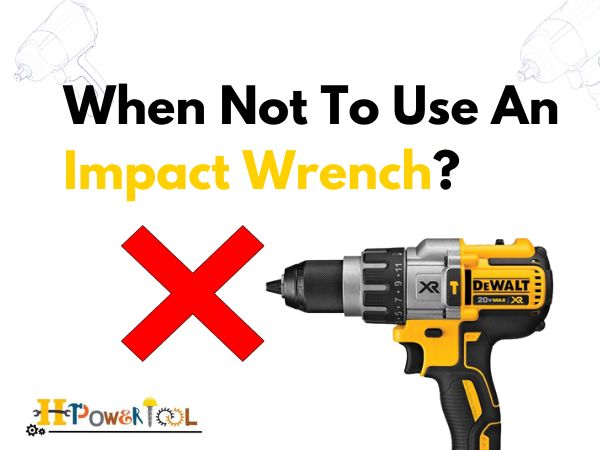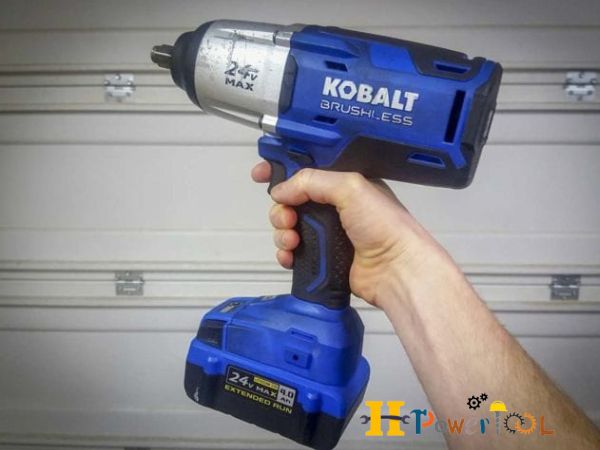When Not To Use An Impact Wrench – Never Done This Mistake

Auto Amazon Links: No products found.
Impact wrenches are powerful tools that use a rotational hammering action to deliver high torque output. They are commonly used in the automotive and construction industries to tighten and loosen nuts and bolts quickly and efficiently. Impact wrenches are available in both corded and cordless varieties and can range in size from small handheld units to large pneumatic tools. So the question may arise When Not To Use An Impact Wrench?
Contents
- 1 Understanding How Impact Wrenches Work:
- 2 Benefits of Using an Impact Wrench:
- 3 Situations Where Impact Wrenches are Essential:
- 4 When Not to Use an Impact Wrench: An Overview:
- 5 Avoiding Damage to Delicate Materials:
- 6 Overcoming the Limitations of an Impact Wrench:
- 7 The Importance of Torque Control:
- 8 Avoiding Stripped Threads and Broken Bolts:
- 9 Dealing with Seized or Stuck Nuts and Bolts:
- 10 Alternatives to Impact Wrenches:
- 11 Assessing the Strength and Fragility of Your Materials:
- 12 The Risks of Over-tightening or Under-tightening:
- 13 Common Mistakes to Avoid When Using an Impact Wrench:
- 14 Knowing When to Use a Torque Wrench Instead:
- 15 Impact Wrenches and Tight Spaces: A Cautionary Tale:
- 16 When Precision is Critical: Choosing the Right Tool for the Job:
- 17 Maintaining Your Impact Wrench: Tips and Tricks:
- 18 Safety Precautions to Take When Using an Impact Wrench:
- 19 Understanding the Difference between Corded and Cordless Impact Wrenches:
- 20 When to Use a Socket Wrench Instead of an Impact Wrench:
- 21 Why Air Tools May Not Be the Best Option for Your Project:
- 22 Balancing Speed and Control: When to Use an Impact Wrench and When Not to:
- 23 The Importance of Proper Training for Impact Wrench Use:
- 24 Conclusion: Making Informed Decisions about Your Tools:
Understanding How Impact Wrenches Work:
Impact wrenches work by applying a sudden burst of rotational force to the fastener. This force is generated by an internal mechanism that drives a hammer or anvil in a circular motion. The hammer or anvil then makes contact with the fastener, causing it to turn. The sudden force allows the impact wrench to loosen or tighten bolts that would otherwise be too difficult to remove or install manually.
Benefits of Using an Impact Wrench:
Impact wrenches can offer several benefits, including speed and efficiency, high torque output, and reduced physical strain on the user. They can also be particularly useful in tight spaces where manual tools are not able to reach them.
Situations Where Impact Wrenches are Essential:
Impact wrenches are essential in many situations, including automotive repair, construction, and heavy machinery. They can be particularly useful in situations where bolts or nuts are rusted, seized, or over-tightened.
When Not to Use an Impact Wrench: An Overview:
While impact wrenches are useful tools, there are certain situations where they should not be used. In these situations, using an impact wrench can cause damage to the fastener or the surrounding area. The following sections will discuss in more detail when not to use an impact wrench and why.
Avoiding Damage to Delicate Materials:
Impact wrenches should not be used on delicate or fragile materials that can be easily damaged. This includes materials such as plastic, fiberglass, or thin metal. The sudden force generated by an impact wrench can cause these materials to crack, deform, or break.
Overcoming the Limitations of an Impact Wrench:
Impact wrenches have limitations, and it is important to recognize when they may not be the best tool for the job. For example, impact wrenches may not be suitable for applications that require a high level of precision, such as when installing delicate electronic components.
The Importance of Torque Control:
Over-tightening or under-tightening bolts can cause serious problems, such as stripped threads, broken bolts, or damage to the surrounding materials. Impact wrenches do not provide the same level of precision as torque wrenches, making them less suitable for applications that require accurate torque control.
Avoiding Stripped Threads and Broken Bolts:
When used incorrectly, impact wrenches can easily strip threads or break bolts. This can be particularly problematic when working with older or rusty fasteners, where the risk of damage is higher.
Dealing with Seized or Stuck Nuts and Bolts:
While impact wrenches are useful for removing seized or stuck nuts and bolts, there are situations where they may not be effective. In some cases, using an impact wrench can actually cause the fastener to become more stuck or damaged.
Alternatives to Impact Wrenches:
There are several alternatives to impact wrenches that can be used in situations where an impact wrench is not suitable. These include manual tools, such as ratchets and wrenches, as well as electric and pneumatic tools.

Assessing the Strength and Fragility of Your Materials:
Before using an impact wrench, it is important to assess the strength and fragility of the materials you are working with. This can help you determine whether an impact wrench is suitable for the job or if another tool should be used instead.
The Risks of Over-tightening or Under-tightening:
Over-tightening or under-tightening bolts can cause serious problems, such as leaks, structural damage, or safety hazards. It is important to understand the recommended torque specifications for each bolt and to use a torque wrench when necessary.
Common Mistakes to Avoid When Using an Impact Wrench:
Using an impact wrench requires skill and knowledge to avoid common mistakes. These mistakes include using the wrong socket size, applying too much force, and not using the proper safety equipment.
Knowing When to Use a Torque Wrench Instead:
Torque wrenches provide accurate torque control and are necessary for applications that require precise tightening. Understanding when to use a torque wrench instead of an impact wrench is important to avoid damaging the fastener or surrounding materials.
Impact Wrenches and Tight Spaces: A Cautionary Tale:
While impact wrenches can be useful in tight spaces, there are risks involved. Using an impact wrench in a confined space can cause injury or damage to the surrounding area.
When Precision is Critical: Choosing the Right Tool for the Job:
In applications where precision is critical, it is important to choose the right tool for the job. This may mean using a torque wrench or a manual tool instead of an impact wrench.

Maintaining Your Impact Wrench: Tips and Tricks:
Maintaining your impact wrench can prolong its life and ensure that it operates safely and effectively. This includes regular cleaning, lubrication, and inspection.
Safety Precautions to Take When Using an Impact Wrench:
Using an impact wrench can be dangerous if proper safety precautions are not taken. This includes wearing proper personal protective equipment, using the correct socket size, and following manufacturer instructions.
Understanding the Difference between Corded and Cordless Impact Wrenches:
Corded and cordless impact wrenches have different advantages and limitations. Understanding the differences can help you choose the right tool for the job.
When to Use a Socket Wrench Instead of an Impact Wrench:
Socket wrenches are manual tools that provide precise torque control. Knowing when to use a socket wrench instead of an impact wrench can prevent damage to the fastener or surrounding materials.
Why Air Tools May Not Be the Best Option for Your Project:
While pneumatic impact wrenches are powerful tools, they may not be suitable for all projects. Factors such as cost, noise level, and accessibility may make other tools a better option.
Balancing Speed and Control: When to Use an Impact Wrench and When Not to:
Using an impact wrench requires a balance between speed and control. Knowing when to use an impact wrench and when to use another tool is essential for achieving the best results.
The Importance of Proper Training for Impact Wrench Use:
Proper training is necessary for safe and effective use of an impact wrench. This includes understanding the tool’s limitations, proper technique, and safety precautions.
Conclusion: Making Informed Decisions about Your Tools:
Knowing when to use an impact wrench and when not to is essential for achieving the best results and avoiding damage to the fastener or surrounding materials. By understanding the tool’s limitations and considering alternative options, you can make informed decisions about which tool to use for each project.
What materials should I avoid using an impact wrench on?
Answer: Delicate materials such as wood, plastic, and soft metals should be avoided when using an impact wrench.
What are the risks of using an impact wrench on delicate materials?
Answer: Using an impact wrench on delicate materials can cause damage such as cracking, splitting, or deformation.
Can I use an impact wrench to tighten bolts to a specific torque value?
Answer: While some impact wrenches have torque control features, it’s recommended to use a torque wrench for precise torque values.
What safety precautions should I take when using an impact wrench?
Answer: Always wear appropriate safety gear such as eye and ear protection. Ensure a stable footing and secure workpiece. Avoid wearing loose clothing or jewelry that could get caught in the tool.
Auto Amazon Links: No products found.
Auto Amazon Links: No products found.






